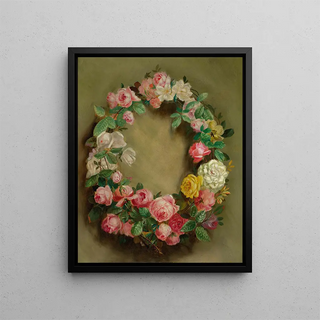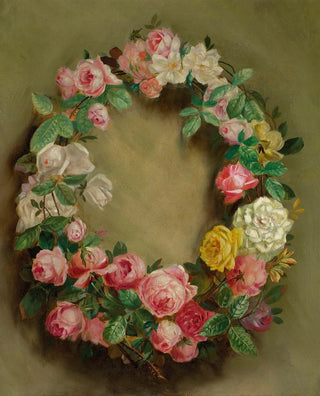Art print | Crown of roses - Pierre-Auguste Renoir


View from behind

Frame (optional)
Pierre-Auguste Renoir’s “Rose Crown” is an iconic artwork that embodies the beauty and elegance of the Impressionist movement. Painted at the end of the 19th century, this canvas evokes an atmosphere of softness and light, where flowers bloom in a palette of vibrant and delicate colors. Through this piece, Renoir manages to capture the fleeting nature of natural beauty, offering viewers a unique sensory experience. The “Rose Crown” is not merely a floral representation but transcends the boundaries of art to become an ode to life and love, inviting everyone to immerse themselves in a universe where nature and emotion meet.
Style and uniqueness of the work
What sets the “Rose Crown” apart is Renoir’s distinctive approach to composition and color. The artist uses fluid, light brushstrokes to bring the delicate petals of the roses to life, creating a sense of movement and lightness. The juxtaposition of pink, white, and green hues is executed with such mastery that it almost seems to vibrate under the light. Renoir, true to his Impressionist technique, does not seek to reproduce reality literally but rather to evoke an impression, a sensation. Shadows and lights blend harmoniously, giving the artwork depth that draws the eye and invites wonder. This ability to capture the ephemeral makes the “Rose Crown” a true masterpiece, a timeless representation of nature in its purest splendor.
The artist and his influence
Pierre-Auguste Renoir, an emblematic figure of Impressionism, left a lasting mark on art history through his innovative approach and artistic sensitivity. Born in 1841 in Limoges, he established himself as one of the masters of his time, influencing generations of artists with his unique vision and refined technique. Renoir did not merely paint landscapes or scenes of daily life; he sought to express emotions, to capture moments of happiness and beauty.

Matte finish

View from behind

Frame (optional)
Pierre-Auguste Renoir’s “Rose Crown” is an iconic artwork that embodies the beauty and elegance of the Impressionist movement. Painted at the end of the 19th century, this canvas evokes an atmosphere of softness and light, where flowers bloom in a palette of vibrant and delicate colors. Through this piece, Renoir manages to capture the fleeting nature of natural beauty, offering viewers a unique sensory experience. The “Rose Crown” is not merely a floral representation but transcends the boundaries of art to become an ode to life and love, inviting everyone to immerse themselves in a universe where nature and emotion meet.
Style and uniqueness of the work
What sets the “Rose Crown” apart is Renoir’s distinctive approach to composition and color. The artist uses fluid, light brushstrokes to bring the delicate petals of the roses to life, creating a sense of movement and lightness. The juxtaposition of pink, white, and green hues is executed with such mastery that it almost seems to vibrate under the light. Renoir, true to his Impressionist technique, does not seek to reproduce reality literally but rather to evoke an impression, a sensation. Shadows and lights blend harmoniously, giving the artwork depth that draws the eye and invites wonder. This ability to capture the ephemeral makes the “Rose Crown” a true masterpiece, a timeless representation of nature in its purest splendor.
The artist and his influence
Pierre-Auguste Renoir, an emblematic figure of Impressionism, left a lasting mark on art history through his innovative approach and artistic sensitivity. Born in 1841 in Limoges, he established himself as one of the masters of his time, influencing generations of artists with his unique vision and refined technique. Renoir did not merely paint landscapes or scenes of daily life; he sought to express emotions, to capture moments of happiness and beauty.






